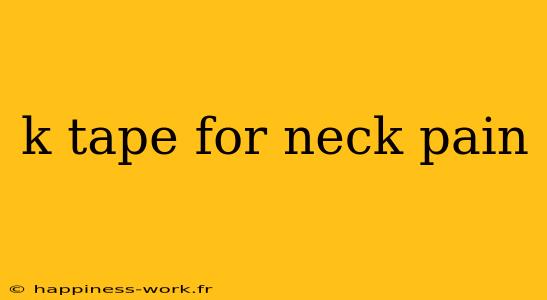Neck pain is a common issue that affects many individuals, often due to poor posture, muscle strain, or injury. One popular method for alleviating neck pain is the use of kinesiology tape, commonly known as K tape. This article explores what K tape is, how it works, its application for neck pain, and additional tips for effective use.
What is K Tape?
Kinesiology tape is a thin, stretchy cotton strip that is designed to ease pain and disability from athletic injuries and a variety of other physical disorders. Developed in the 1970s by Japanese chiropractor Dr. Kenzo Kase, K tape aims to support muscles and joints without restricting the body’s range of motion.
How Does K Tape Work for Neck Pain?
K tape works on the principle of lifting the skin away from the underlying tissues, which can help reduce swelling and improve circulation. When applied to the neck, K tape can:
- Support Muscles: Provides gentle support to sore or strained muscles in the neck.
- Reduce Inflammation: Facilitates lymphatic drainage, which can decrease swelling and help with recovery.
- Improve Posture: By supporting the proper alignment of the neck, it can help prevent further strain.
How to Apply K Tape for Neck Pain
Applying K tape correctly is crucial for achieving the desired benefits. Here’s a step-by-step guide inspired by WikiHow:
- Gather Your Supplies: You will need K tape, scissors, and possibly a partner to help with the application.
- Measure the Tape: Cut two strips of K tape, each about 10 inches long.
- Prepare the Skin: Clean the skin around the neck to ensure the tape adheres well.
- Position the First Strip: Apply the first strip of tape starting at the base of your neck and stretching it upwards towards the ear. Leave the ends of the tape unstretched.
- Apply the Second Strip: Use the second strip of tape parallel to the first, making sure to space them evenly.
- Rub the Tape: After applying, rub the tape gently to activate the adhesive.
Additional Tips for Effective Use
- Consult a Professional: It’s always wise to consult with a physical therapist or healthcare professional for proper evaluation and advice regarding neck pain before using K tape.
- Combine with Other Treatments: Consider combining K tape with other treatments such as physical therapy, massage, and posture correction for optimal results.
- Monitor Your Body’s Response: Pay attention to how your neck responds to the tape. If you experience increased pain or discomfort, remove the tape and consult a professional.
Is K Tape Right for Everyone?
While K tape can be an effective tool for managing neck pain, it might not be suitable for everyone. People with skin sensitivities or allergies to adhesives should use caution. Furthermore, those with underlying medical conditions should seek advice from a healthcare professional before trying K tape.
Additional Strategies for Neck Pain Relief
While K tape can provide relief, incorporating other strategies can enhance recovery:
- Posture Awareness: Maintain good posture throughout the day, especially if you sit for long periods. Using ergonomic furniture can also help.
- Stretching and Strengthening Exercises: Incorporate gentle neck stretches and strengthening exercises to improve flexibility and stability.
- Heat Therapy: Applying heat can relax tight muscles and increase blood flow to the affected area.
- Regular Breaks: If you work at a desk, take regular breaks to stand, stretch, and move around.
Conclusion
K tape can be a valuable tool for alleviating neck pain when applied correctly and used alongside other treatments and lifestyle changes. Always consult with a healthcare provider to tailor the best approach to your individual needs.
For more detailed instructions and insights, you can refer to the original article on WikiHow.
By following these guidelines, you can make the most of K tape for neck pain while ensuring a holistic approach to your health and well-being. Remember that the path to recovery is often multi-faceted, and understanding your body is key to effective pain management.
